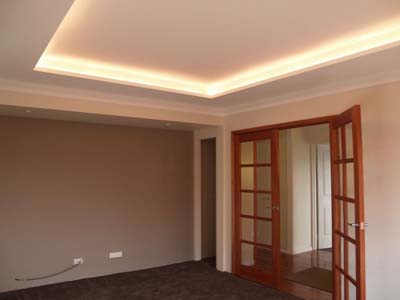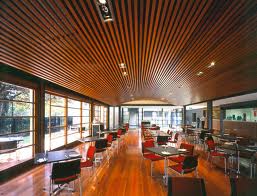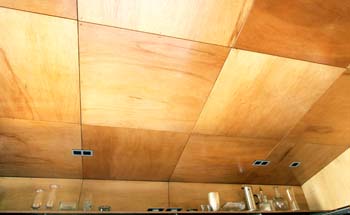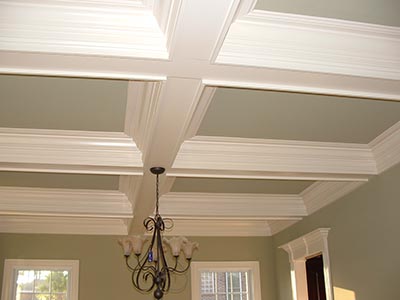
Plasterboard ceiling with bulkhead detailing
The first step in fitting out the internal spaces is to fix the ceiling and wall linings. The most common lining for ceilings is plasterboard. For residential buildings the choice of ceiling claddings is as endless as your imagination, but unless you are planning to install your own ceilings, anything other than basic plasterboard will cost more. The more detail involved, the higher the cost.
Plasterboard ceilings
Plasterboard (available from any building supplies outlet) is sandwich format sheet, made of a gypsum plaster core, sandwiched between outside layers of cardboard. It is the most common method of ceiling cladding in Australia as it is very malleable. Any joins, gaps and holes are filled in with gypsum "putty", tape and then plastered. The joins and holes are then sanded smooth.
The straightness of plaster ceilings are only as good as the framing to which it is fixed. A straight edge piece of timber or similar should be moved across the bare ceiling joists to ensure that the joists are in true alignment. If the ceiling joists are not aligned they will need to be either trimmed back or packed out with thin pieces of timber.
The thickness of the Gyprock required will depend on the distance between trusses or ceiling joist members, but it is generally 10 mm for ceilings. For ceiling with joists every 600 mm, special lightweight plasterboard with anti-sag properties should be used. For ceilings in wet areas plasterboard is not advised and a fibre cement sheeting is required to prevent moisture absorption.
Plasterboard can also be used as a detailing material to create Coffered ceilings and lighting bulkheads. Read more about these further on.
Timber ceilings

Timber Ceiling created by Cedar Sales
Timber ceilings have been around for a while but they are still not commonly used. Simply designed wood ceilings are probably the most cost effective option after plain plasterboard ceilings. Timber panels are often used on vaulted and cathedral ceilings, but can also great on high flat ceilings; painted, oiled, lime washed or varnished.
Timber ceiling linings come in many profiles and come in plank form or in sheets. The profile you choose will affect the cost of installation, finishing and maintenance. The most common type of timber used for ceiling cladding is Radiata Pine or Western Red Cedar. See Cedarsales here for an overview of their ceiling lining products.
Prefinished timbers (or pre-primed timbers) are available in tongue and grooved profiles or in panels (which make fixing easier and quicker). They come in a variety of timber types and colours. Remember - dark timbers will make a smaller room look even smaller, and light colours with make a small room seem bigger.
Colorbond ceilings
Colorbond is a relatively new ceiling cladding to the mass housing market. Having said that Colorbond ceiling linings are well established in the high-end beach home market, and come in many profiles and forms.
There is a new sandwich panel on the market that has a polystyrene type core sandwiched between Colorbond sheeting. This type of product is very cost effective as it saves on skilled roofing, carpentry and plastering services. See the Corrospan product here.
Plywood

Semigloss-treated plywood
ceiling in herringbone pattern
Plywood is an easy to install and cost effective option for lining ceilings.
Plywood can be fixed to ceiling joists with a shadow line (groove) between the panels. For this to visually work at its best the timber beneath the groove is best painted matt black. The join between the panels, if exposed, must be exactly the same width; which is sometimes tricky if some of the walls are not square. Fixing the ply sheets can be very difficult due to the fact that it's hard working overhead with large panels (and will require 2 or 3 people to do it).
Alternatively, a strip of timber can be fixed over the groove (shadow line). But this method can detract from the appeal that an expanse of shadow line detailing can provide.
Coffered ceilings and bulkhead detailing

Coffered Ceiling
Coffered ceilings and bulkhead detailing are the easiest ways to chew into your ceiling budget. They are very labour intensive to install, but they are gorgeous...
- detailed drawings should be prepared by a professional (see a specialist building designer or architect)
- a carpenter will need to read the drawing details and form up the ceiling with timber then plasterboard.
-
a plasterer will then fill in the joins and patches, and add mouldings if required.
-
and finally the painter will coat the detailed surface, which is more time consuming than a flat surface.
Installing a ceiling that is different from the average flat plasterboard ceiling is what many people envisage having in their home. But the reality is many people don't, due to the labour intensive cost factors. Researching your options and comparing the costs of products as well as their installation will be essential if you want to install a ceiling that is a little different and within your budget.
<<PREV PAGE NEXT PAGE >>The building process series of articles
This article is one in a series which covers everything from laying the foundations to selecting the finishes. Click on the following link if you would like to learn more about the building process for new houses.
